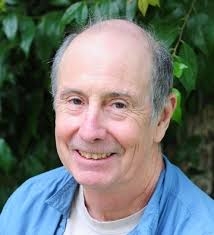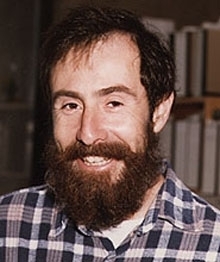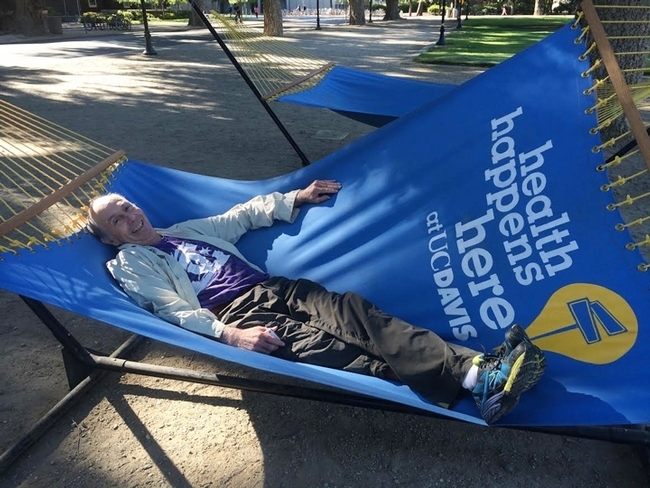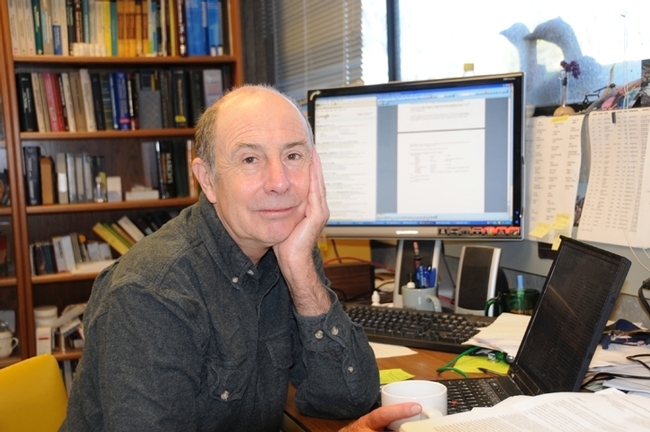
Yes, that's UC Davis distinguished professor Bruce Hammock "resting" in a hammock on the UC Davis campus.
But as his family, friends, students and colleagues can testify, the indefatigable professor, inventor, researcher, scientist, author, CEO and athlete does not rest...much less rest in a hammock!
Cindy McReynolds of the Hammock lab, a UC Davis doctoral student in pharmacology/toxicology, coaxed him to pose for that image when some of the Hammock lab folks were heading across campus (before the coronavirus pandemic precautions).
And now we're delighted to see that Hammock, internationally recognized for his work in alleviating inflammatory and neuropathic pain in humans and companion animals--and known as the founder of the field of environmental immunoassays--is the recipient of the prestigious Lifetime Achievement Award in Innovation, part of the 2020 Chancellor's Innovation Awards.
An honor well-deserved!
The annual campuswide award honors researchers who have made a long-term positive impact on the lives of others and who inspire other innovators. It is one of several awards announced June 15 in a program managed by the Office of Research. (See recipients.)
“Research universities like UC Davis play a critical role in advancing innovative solutions for the global community that not only stimulate our economy but create a better quality of life,” said Chancellor Gary S. May in a news release. “The recipients of this year's awards demonstrate the impact of reaching beyond what is expected to deliver game-changing innovations that address some of the world's most critical issues.”
Hammock, who holds a joint appointment with the Department of Entomology and Nematology and the UC Davis Comprehensive Cancer Center, co-discovered a human enzyme termed Soluble Epoxide Hydrolase (sEH), a key regulatory enzyme involved in the metabolism of fatty acids. It regulates a new class of natural chemical mediators, which in turn regulates inflammation, blood pressure and pain. Hammock and his lab have been involved in enzyme research for more than 50 years.

UC Davis recently licensed certain patents exclusively to EicOsis that support the underlying technology.
Hammock traces the history of his enzyme research to 1969 to his graduate student days in the John Casida laboratory, UC Berkeley. Hammock was researching insect developmental biology and green insecticides when he and colleague Sarjeet Gill, now a distinguished professor at UC Riverside, discovered the target enzyme in mammals that regulates epoxy fatty acids.
“My research led to the discovery that many regulatory molecules are controlled as much by degradation and biosynthesis,” Hammock said. “The epoxy fatty acids control blood pressure, fibrosis, immunity, tissue growth, depression, pain and inflammation to name a few processes.”
The National Institute on Drug Abuse awarded a $15 million HEAL grant (Helping to End Addiction Long-term Initiative) to EicOsis in 2019 to support human clinical trials of a novel compound that has been found effective for the treatment of pain in preclinical animal studies.
In 2019, Hammock received a $6 million “outstanding investigator” federal grant for his innovative and visionary environmental health research. His pioneering work on inflammation not only extends to alleviating chronic pain, but to targeting inflammation involved in cancer, cardiovascular diseases, diabetes and other health issues.
EicOsis won the Sacramento Region Innovation Award in the Medical and Health category in 2019.
More recently, Hammock has turned his attention to using sEH as a means to control the deadly cytokine storm associated with COVID-19.
A member of the UC Davis faculty since 1980, Hammock has directed the UC Davis Superfund Research Program (funded by the National Institutes of Health's National Institute of Environmental Health Sciences) for nearly four decades, supporting scores of pre- and postdoctoral scholars in interdisciplinary research in 5 different colleges and graduate groups on campus. He is a fellow of the National Academy of Inventors and the National Academy of Sciences, and the Entomological Society of America. He is the recipient of scores of awards, including the first McGiff Memorial Awardee in Lipid Biochemistry; and the Bernard B. Brodie Award in Drug Metabolism, sponsored by the America Society for Pharmacology and Experimental Therapeutics. At UC Davis he received the Distinguished Teaching Award and the Faculty Research Lectureship.
He has authored or co-authored more than 1,200 peer-reviewed publications and holds more than 95 patents in agriculture, environmental science and medicinal chemistry.
Hammock is known for his expertise in chemistry, toxicology, biochemistry and entomology. Earlier in his career, he founded the field of environmental immunoassay, using antibodies and biosensors to monitor food and environmental safety, and human exposure to pesticides. His groundbreaking research in insect physiology, toxicology led to his development of the first recombinant virus for insect control.
As director of the UC Davis Superfund Research Program, he pioneered trans-disciplinary research across campus, engaging faculty in multiple colleges and schools “to transform the way we treat diseases in multiple species.”
A native of Little Rock, Ark., Hammock received his bachelor's degree in entomology (with minors in zoology and chemistry) magna cum laude from Louisiana State University, Baton Rouge, in 1969. He received his doctorate in entomology-toxicology from UC Berkeley in 1973. Hammock served as a public health medical officer with the U.S. Army Academy of Health Science, San Antonio, and as a postdoctoral fellow at the Rockefeller Foundation, Department of Biology, Northwestern University, Evanston, Ill.
In the Army, Hammock served as a medical officer at Fort Sam, Houston, and what he saw--severely burned people in terrible pain--made a lasting impression on him and steered him toward helping humankind.
The rest, as they say, is history: "his story" that is drawing worldwide attention.
Links:
Attached Images:

UC Davis distinguished professor Bruce Hammock "rests" in a hammock on the UC Davis campus. The occasion: the Hammock lab scientists were walking across campus (before the coronoavirus pandemic precautions). (Photo by Cindy McReynolds)

UC Davis distinguished professor Bruce Hammock in his Briggs Hall office. (Photo by Kathy Keatley Garvey)